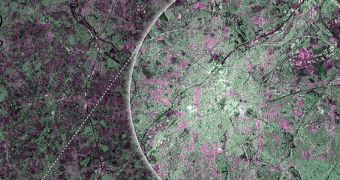Officials with the European Space Agency (ESA) have just released one of the first-ever images captured by its new Sentinel-1A satellite. The spacecraft was launched on April 3 and was able to collect its first image on April 12, just one day after the intricate dance of getting it into its designated orbital perch was concluded. The image above centers on the city of Brussels, in Belgium.
Brussels was selected because it is the seat of the European Commission, one of the lead governing bodies in the European Union. The Commission leads the Copernicus program through the ESA, and Sentinel-1A is the first satellite in the Copernicus constellation. Its twin, Sentinel-1B, will be launched into space next year, according to the European flight manifest for 2015.
These early radar images the satellite has captured with its state-of-the-art C-band Synthetic Aperture Radar (SAR) instrument are just a taste of what the mission will be capable of. Mission controllers at ESA say that the SAR has not yet been entirely calibrated, adding that the mission-ready data Sentinel-1A will collect will be even more detailed than the one you can feast your eyes on above.
The mission is currently in its commissioning phase, which is scheduled to last for about three months. During this interval, scientists will calibrate the SAR instrument to its fullest potential and will also move the satellite into its final operational orbit. “We are exceptionally happy with this first set of images,” commented Volker Liebig, the director of the Earth Observation Program at ESA.
“We are in very early days of the satellite’s life in orbit and ground segment operations, but these images certainly demonstrate the calibre of data this advanced radar mission will bring from its different imaging modes, and how it will provide essential data for Copernicus services to benefit us all,” he concluded.

 14 DAY TRIAL //
14 DAY TRIAL //